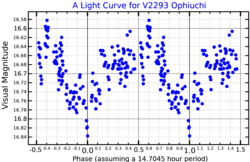 A visual band light curve showing superhumps of V2293 Ophiuchi, adapted from Masetti et al. (1996) | |
| Observation data Epoch J2000 Equinox J2000 | |
|---|---|
| Constellation | Ophiuchus |
| Right ascension | 17 19 37 |
| Declination | −25° 01′ 03″ |
| Apparent magnitude (V) | 16.65 |
| Astrometry | |
| Distance | 8500 ly (2600 pc) |
| Absolute magnitude (MV) | ≥6 |
| Database references | |
| SIMBAD | data |
GRO J1719-24 (GRS 1716-249, V2293 Oph, X-Ray Nova Ophiuchi 1993) is believed to be a low-mass X-ray binary. Its name derives from an X-ray transient, detected in 1993. The system consists of a black hole candidate and a low mass companion, estimated to be a main sequence star of the spectral type K0-5 V.
The rotation period is uncertain, estimated at 14.7h. The light curve possibly exhibits some faster fluctuations as well, which are hypothesized to be produced by blobs of matter in the accretion disk.
References
- ^ Masetti, N.; Bianchini, A.; Bonibaker, J.; della Valle, M.; Vio, R. (October 1996). "The superhump phenomenon in GRS 1716-249 (=X-Ray Nova Ophiuchi 1993)". Astronomy and Astrophysics. 314: 123–130. Bibcode:1996A&A...314..123M. Retrieved 5 February 2022.
- ^ Della Valle, M.; Mirabel, I.F.; Rodriguez, L.F. (1994), "The optical and radio counterpart of the X-ray Nova Ophiuchi 1993", Astronomy and Astrophysics, 290: 803, Bibcode:1994A&A...290..803D
- Ballet, J.; Denis, M.; Gilfanov, M.; R., Sunyaev (1993), IAU Circ., vol. 5874
- Chaty, S.; Mirabel, I. F.; Goldoni, P.; Mereghetti, S.; Duc, P.-A.; Martí, J.; Mignani, R. P. (2002), "Near-infrared observations of Galactic black hole candidates", MNRAS, 331 (4): 1065–1071, arXiv:astro-ph/0112329, Bibcode:2002MNRAS.331.1065C, doi:10.1046/j.1365-8711.2002.05267.x, S2CID 15529877
This binary or multiple star system–related article is a stub. You can help Misplaced Pages by expanding it. |